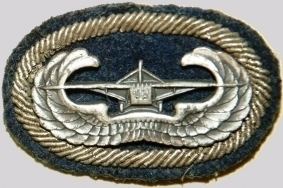 | ||
The Glider Badge was a qualification badge of the United States Army. According to the U.S. Army Institute of Heraldry, the badge was awarded to personnel who had "been assigned or attached to a glider or airborne unit or to the Airborne Department of the Infantry School; satisfactorily completed a course of instruction, or participated in at least one combat glider mission into enemy-held territory. The badge was authorized on 22 July 1944 A cloth circle with a glider similar to the parachute cap insignia was worn on the overseas cap.
Following the close of the Second World War, the Glider Badge was authorized to any service member who had completed glider unit training at the Airborne School.
Glider-borne soldiers wore a wing trimming (a.k.a. oval) behind their Glider Badges to signify assignment to glider units. The color pattern of the trimming varied depending upon the unit. (Note: During World War II the term "Airborne" included parachute, glider, and air-landing units. With the elimination of glider and air-landing units from the force structure in the post-war years, Airborne became synonymous with parachute units only.)
In the post-World War II years, the US Army converted its remaining glider units to parachute. For example, the 325th Glider Infantry Regiment of the 82d Airborne Division was reorganized and redesignated on 15 December 1947 as the 325th Infantry Regiment (no longer glider infantry), and then reorganized and redesignated again on 15 December 1948 as the 325th Airborne Infantry. Likewise, the 319th Glider Field Artillery Battalion, also part of the 82d Airborne Division, was reorganized and redesignated on 15 December 1947 as the 319th Field Artillery Battalion, and then reorganized and redesignated on 15 December 1948 as the 319th Airborne Field Artillery Battalion. Although glider units had ceased to exist, the badge was not formally rescinded until 3 May 1961; however, it remained authorized for wear by those who earned it.
By 1949 glider training still took place but was included in the basic Airborne course, which was then five weeks long. The first week of the course covered air transportability training, which included glider training. During late summer of that year, a glider crashed, killing many of those on board, and glider training came to an end.
Glider Operations during World War II
U.S. Army glider units participated in eight glider-airborne operations during World War II:
